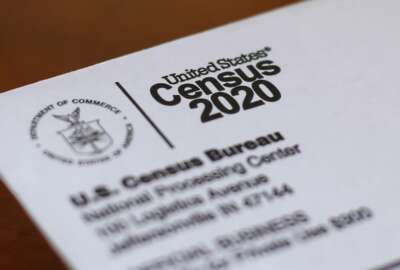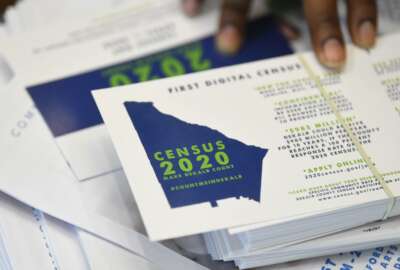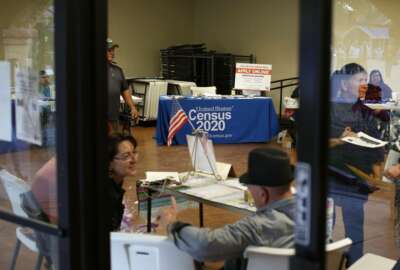
2020 census internet self-response exceeds goals amid pandemic
A senior Democratic Committee aide told Federal News Network that bureau officials expected internet self-response at this point would be around 36%, but so far,...
The Census Bureau, rolling with the punches as the pandemic disrupts field operations for the 2020 population count, has seen its top technology innovation exceed expectations.
With dozens of states and the District of Columbia keeping stay-at-home orders or similar restrictions in place, the bureau has seen more households opt to respond to the 2020 census via the internet than it had expected.
Al Fontenot, the associate director for decennial census programs, told members of the House Oversight and Reform Committee in a briefing last Friday that the internet self-response rate has exceeded the bureau’s expectations.
A senior Democratic Committee aide told Federal News Network that bureau officials anticipated that internet self-response at this point would be around 36%, but so far, more than 45% of households have completed the online questionnaire.
In total, more than 53% of households have responded to the 2020 census.
Committee Chairwoman Carolyn Maloney (D-N.Y.) said last Friday’s briefing took place after weeks of delays, and following the Trump administration’s request of Congress to push back statutory deadlines for the 2020 count.
“The Census Bureau has the difficult task of achieving a complete, accurate, and fair count while also protecting the health of census workers and the American public,” Maloney said in a statement. “I support the bureau’s efforts in this challenging time, but the Constitution gives Congress the responsibility to determine how the Census is conducted. We expect the Bureau to work closely with us going forward so we can overcome this public health crisis and make the Census a success.”
The bureau’s other innovation, however, over-the-phone response, has fallen short of expectations.
Bureau officials projected 6.8% of responses would happen over the phone, but so far only 0.6% of respondents have opted for it.
“Some people have complained of long wait times, but bureau officials asserted that these had been corrected,” committee officials wrote in a press release on Monday.
Internet self-response and the IT infrastructure to support it has been the source of several reports from the Commerce Department inspector general and the Government Accountability Office for the past few years.
But responding over the internet also means the bureau has immediate access to electronic records and reduces the need for post-collection processing, former Census Bureau Director Robert Groves told Federal News Network.
“In my book, the jury is out on this, and it works sufficiently well that I can’t imagine the next census not using it,” Groves said in an interview earlier this month.
A higher total self-response rate also reduces the need for the bureau to hire enumerators to knock on doors later this year and collect responses.
Census Bureau Steven Dillingham told the committee in February that if the total response rate reached 60.5%, which is close to what the bureau expects, then it would need about 320,000 enumerators to follow up and complete the count.
By contrast, a self-response rate below 55%, a “worst-case scenario” that Dillingham said the bureau doesn’t expect, would necessitate hiring as many as 500,000 enumerators to complete non-response follow-up.
Earlier this month, Commerce Department and White House officials recommended putting 2020 census field operations on hold through June 1. That request, however, would require lawmakers to move a statutory deadline for the bureau to send the decennial count data to Congress and the president by Dec. 31.
During the coronavirus pandemic, the bureau has reached into its $2 billion contingency fund, but Chief Financial Officer Ben Page told the committee that the bureau only expects to spend $1.5 billion from the fund because of coronavirus-related disruptions.
Bureau considers ‘phased approach’ to reopen field offices
While the administration still seeks to push that deadline back to April 2021, Fontenot said the bureau is considering a “phased start” to field operations rather than resume nationwide.
Those plans, he told the committee, are contingent on federal, state, and local public health guidance, as well as the availability of personal protective equipment. A top priority for the bureau, Fontenot said, is reopening mail processing centers and census offices.
While the bureau will pursue a phased reopening, officials are still asking Congress to push back statutory deadlines for the 2020 census.
Dillingham said Congress remains“absolutely vital to our success,” and said the bureau will provide regular updates on its operations.
While internet self-response rates have shown promise, the bureau is stepping up efforts to reach hard-to-count communities that don’t have reliable internet access.
Ali Ahmad, the associate director for communications, said the bureau is increasing its outreach budget for minority and other hard-to-reach communities from $240 million to $320 million.
The bureau, he said, is also conducting more “hyper-local” outreach and expanding the number of languages in paid media from 14 to 40.
Last week, Arturo Vargas, the CEO of the National Association of Latino Elected and Appointed Officials Educational Fund, told the committee that the response rate in counties with a higher population of Latinos is about 20% lower than counties with lower populations of Latinos.
Copyright © 2024 Federal News Network. All rights reserved. This website is not intended for users located within the European Economic Area.
Jory Heckman is a reporter at Federal News Network covering U.S. Postal Service, IRS, big data and technology issues.
Follow @jheckmanWFED
Related Stories





